Training your pecs is a important part of strengthening and trimming your chest. Whether you are a workout enthusiast or coming up with your first training plan, the exercises below will help you meet your fitness goals.
hyght dumbbell fly
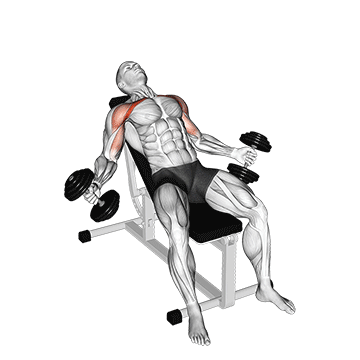
1. Start by selecting a pair of dumbbells that you can comfortably lift. Remember, the goal is to perform the exercise correctly, not to lift the heaviest weight possible.
2. Stand upright with your feet shoulder-width apart. Hold a dumbbell in each hand with your palms facing forward.
3. Extend your arms out to your sides until they are level with your shoulders. This is your starting position.
4. Slowly lower the dumbbells in a wide arc until they are level with your chest. Keep your elbows slightly bent to avoid straining your joints.
5. Pause for a moment at the bottom of the movement, then use your pecs to reverse the motion and bring the dumbbells back up to the starting position.
6. Make sure to keep your back straight and your core engaged throughout the exercise.
7. Repeat this movement for your desired number of reps.
Remember, the key to this exercise is control. Don't rush the movement, and make sure to fully engage your pecs as you lift the dumbbells.
dumbbell straight arm pullover
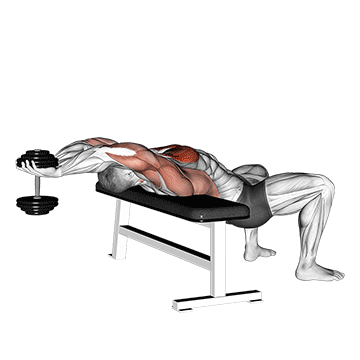
1. Start by selecting a dumbbell of appropriate weight. Remember, it's always better to start light and gradually increase the weight as you get comfortable with the exercise.
2. Lie down on a flat bench with your feet firmly planted on the ground. Hold the dumbbell with both hands, extending your arms straight above your chest. This is your starting position.
3. Slowly lower the dumbbell back over your head while keeping your arms straight. Continue lowering until your biceps are aligned with your ears or you feel a stretch in your chest.
4. Pause for a moment at the bottom of the movement, then slowly raise the dumbbell back to the starting position. Make sure to keep your arms straight throughout the movement.
5. Repeat this movement for the desired number of repetitions.
6. Ensure to keep your movements slow and controlled, focusing on the stretch and contraction of the pecs. Avoid using your back or shoulders to lift the weight; your pecs should be doing the work.
7. Remember to breathe in as you lower the dumbbell and breathe out as you lift it back to the starting position.
8. Always maintain a slight bend in your elbows to avoid strain or injury.
9. For best results, perform this exercise in a slow and controlled manner, focusing on the muscle-mind connection.
10. After completing your set, carefully place the dumbbell back on the ground to avoid injury.
dumbbell reverse bench press
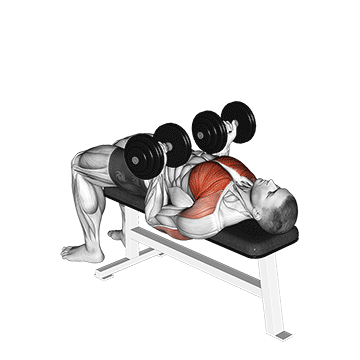
1. Start by selecting a pair of dumbbells that you're comfortable with. Ensure the weight is challenging but manageable to avoid injury.
2. Lie down on a flat bench with your feet firmly planted on the ground. Hold the dumbbells in each hand at shoulder width.
3. Extend your arms fully, lifting the dumbbells above your chest. This is your starting position.
4. Slowly lower the dumbbells in a controlled manner, bending your elbows to bring the weights down to the sides of your chest. Your palms should be facing towards your feet in a reverse grip, hence the name 'reverse bench press'.
5. Pause for a moment at the bottom of the movement, ensuring your elbows are at a 90-degree angle and not flaring out to the sides.
6. Push the dumbbells back up to the starting position, using your pecs to drive the movement. Ensure your arms are fully extended but not locked at the elbows.
7. Repeat this movement for your desired number of repetitions.
Remember to keep your movements slow and controlled, focusing on the muscle contraction and relaxation. This exercise not only targets your pecs but also works your triceps and shoulders. Always ensure proper form to avoid injury.
dumbbell pullover on exercise ball
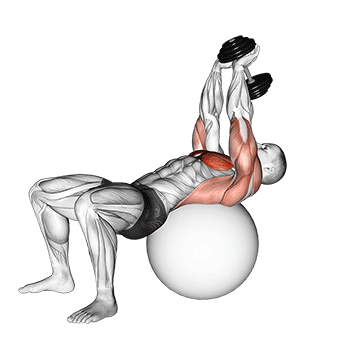
1. Start by selecting a dumbbell of appropriate weight. Remember, it's always better to start light and gradually increase the weight as you get comfortable with the exercise.
2. Position an exercise ball on a flat, stable surface. Sit on the ball with your feet flat on the floor, shoulder-width apart for balance.
3. Carefully walk your feet forward, allowing the ball to roll underneath your body. Continue until the ball is supporting your upper back and shoulders, and your knees are bent at a 90-degree angle. Your body should form a straight line from your knees to your shoulders.
4. Hold the dumbbell with both hands, extending your arms straight up towards the ceiling. This is your starting position.
5. Keeping your arms straight, slowly lower the dumbbell back and over your head until your arms are in line with your body. You should feel a stretch in your chest and shoulders.
6. Pause for a moment, then slowly raise the dumbbell back to the starting position, using your chest muscles to lift the weight.
7. Repeat this movement for your desired number of repetitions.
8. To safely finish the exercise, walk your feet back towards the ball, allowing it to roll back under your body until you are sitting upright again.
Remember to keep your movements slow and controlled, and always maintain a straight body line from your knees to your shoulders.
dumbbell pullover hip extension on exercise ball
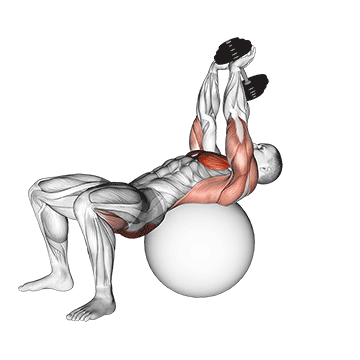
1. Start by selecting a dumbbell of appropriate weight. Remember, it's always better to start light and gradually increase the weight as you get comfortable with the exercise.
2. Position yourself on an exercise ball so that your upper back is resting on the ball. Your feet should be flat on the floor, hip-width apart, and your knees bent at a 90-degree angle. This is your starting position.
3. Hold the dumbbell with both hands, extending your arms straight up towards the ceiling. The dumbbell should be held in such a way that your palms are pressing against the underside of one of the dumbbell's plates.
4. Slowly lower the dumbbell back over your head in an arc. Keep your arms straight and your elbows slightly bent. Continue lowering the dumbbell until it's level with your head or as far as comfortable.
5. Pause for a moment, then use your pecs to pull the dumbbell back up in the same arc until it's directly above your chest again.
6. As you pull the dumbbell back up, engage your glutes and lift your hips off the floor until your body forms a straight line from your knees to your shoulders.
7. Lower your hips back to the starting position as you lower the dumbbell back over your head. This completes one rep.
8. Repeat this exercise for the desired number of repetitions.
Remember to keep your movements slow and controlled, focusing on the muscle contraction and not on the weights you are lifting. Always keep your core engaged throughout the exercise to maintain balance on the exercise ball.
dumbbell pullover
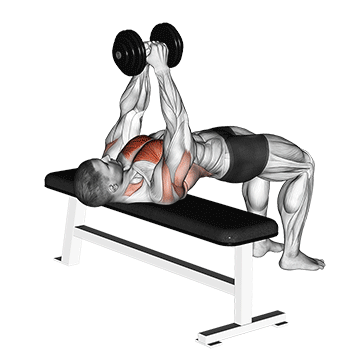
To perform the dumbbell pullover, start by selecting a dumbbell of appropriate weight. Lie down on a flat bench with your feet firmly planted on the ground. Hold the dumbbell with both hands, extending your arms straight above your chest. Your palms should be pressing against the underside one end of the dumbbell.
Take a deep breath and slowly lower the dumbbell back over your head. Keep your arms slightly bent to avoid strain on your biceps and elbows. Lower the weight until your upper arms are in line with your torso, or as far as comfortable.
Exhale and pull the dumbbell back over your chest, returning to the starting position. This completes one rep.
Ensure to keep the movement controlled, focusing on the stretch and contraction of the pecs. Avoid letting your lower back arch off the bench as you lower the weight.
Perform your desired number of reps and sets. This exercise primarily targets the pecs, but also works the lats and triceps.
dumbbell press on exercise ball
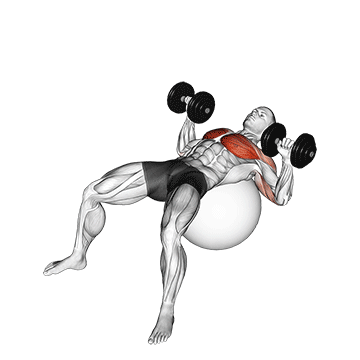
1. Start by selecting a pair of dumbbells that you're comfortable with. Make sure they're not too heavy to prevent injury.
2. Sit on an exercise ball with the dumbbells resting on your thighs.
3. Slowly walk your feet forward, rolling down the ball until your upper back and shoulders are resting on the ball. Your knees should be bent at a 90-degree angle, and your body should form a straight line from your knees to your head.
4. With a dumbbell in each hand, extend your arms straight up over your chest, palms facing each other. This is your starting position.
5. Slowly lower the dumbbells down and out to the sides of your body, keeping a slight bend in your elbows. Continue lowering them until your elbows are about chest level or slightly below.
6. Pause for a moment, then push the dumbbells back up to the starting position, squeezing your chest muscles as you do so.
7. Repeat this movement for your desired number of repetitions.
8. To safely finish the exercise, lower the dumbbells back to your chest and sit up, using your thighs to help lift the weights.
Remember to keep your movements slow and controlled, and always maintain a slight bend in your elbows to prevent strain. Breathe in as you lower the weights and breathe out as you press them up.
dumbbell one leg fly on exercise ball
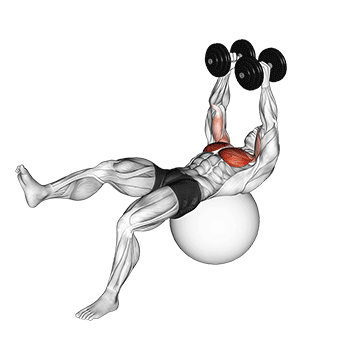
1. Start by selecting a pair of dumbbells of appropriate weight. Remember, it's better to start light and increase weight as you get comfortable with the exercise.
2. Position an exercise ball behind you. Stand with your feet shoulder-width apart and hold a dumbbell in each hand.
3. Carefully step forward with one foot while lifting the other foot off the ground. Simultaneously, lean forward and place your raised leg's shin on the exercise ball.
4. Your body should be in a straight line from your head to your raised foot. Your arms should be extended straight down, holding the dumbbells.
5. Slowly raise the dumbbells out to your sides in a wide arc, keeping a slight bend in your elbows. Continue lifting until your arms are parallel to the floor.
6. Pause for a moment at the top of the movement, then slowly lower the dumbbells back to the starting position.
7. Repeat this movement for your desired number of repetitions. Then switch legs and repeat the exercise.
8. Remember to keep your core engaged and your back straight throughout the exercise. This will help maintain balance and protect your lower back.
9. Breathe out as you lift the dumbbells and breathe in as you lower them. This will help maintain a steady rhythm and ensure your muscles are getting the oxygen they need.
10. Always perform this exercise in a controlled manner. Avoid using momentum to lift the weights, as this can lead to injury.
dumbbell one arm reverse grip press
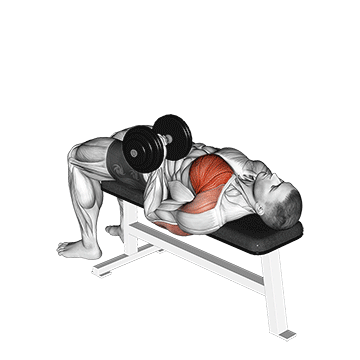
1. Start by selecting a dumbbell of appropriate weight. Remember, it's better to start light and increase weight as you get comfortable with the movement.
2. Stand or sit on a bench with your feet firmly planted on the ground. Hold the dumbbell in one hand with a reverse grip, meaning your palm should be facing towards you.
3. Extend your arm straight up towards the ceiling. This is your starting position.
4. Slowly lower the dumbbell down towards your chest, keeping your elbow close to your body. Your arm should form a 90-degree angle at the bottom of the movement.
5. Pause for a moment at the bottom, then push the dumbbell back up to the starting position. Make sure to exhale as you push the weight up.
6. Repeat this movement for your desired number of repetitions. Once you've completed your set, switch the dumbbell to your other hand and repeat the exercise.
7. Remember to keep your core engaged and your back straight throughout the exercise. This will help to protect your spine and maximize the effectiveness of the movement.
8. For best results, aim for 3-4 sets of 8-12 repetitions on each side.
dumbbell one arm pullover on exercise ball
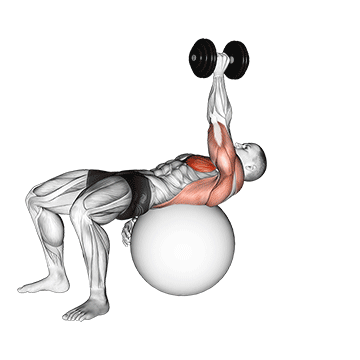
1. Start by selecting a dumbbell of appropriate weight. Remember, it's always better to start light and gradually increase the weight as you get comfortable with the exercise.
2. Position an exercise ball on the floor and sit on it. Hold the dumbbell with both hands, wrapping your fingers around the handle and your palms pressing against the inner weight plates.
3. Slowly walk your feet forward, rolling your back onto the ball until only your shoulders and upper back are supported by the ball. Your knees should be bent at a 90-degree angle, and your body should form a straight line from your knees to your head.
4. Extend your arms straight up over your chest, holding the dumbbell with both hands. This is your starting position.
5. Keeping your arms straight, slowly lower the dumbbell back over your head until your biceps are next to your ears. Your arms should remain straight and your elbows should not bend during this movement.
6. Use your pecs to reverse the movement, pulling the dumbbell back up over your chest. Make sure to keep your hips lifted and your body in a straight line throughout the exercise.
7. Repeat this movement for the desired number of repetitions.
8. After completing your set, carefully walk your feet back towards the ball, sit up, and place the dumbbell on the floor.
Remember to keep your movements slow and controlled, focusing on the muscle contraction and not on the weights you are lifting. Breathe in as you lower the weight and breathe out as you lift it back up.
dumbbell one arm press on exercise ball
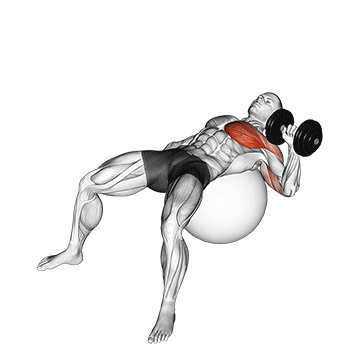
1. Start by selecting a dumbbell of appropriate weight. Remember, it's better to start light and increase weight as you get comfortable with the exercise.
2. Sit on an exercise ball with the dumbbell in one hand. Walk your feet forward, rolling down the ball until your upper back and shoulders are resting on the ball. Your knees should be bent at a 90-degree angle, and your body should form a straight line from your knees to your shoulders.
3. Hold the dumbbell in your hand with your arm fully extended above your chest, palm facing away from you. This is your starting position.
4. Slowly lower the dumbbell down and to the side, keeping your elbow slightly bent. Continue lowering the weight until your elbow is in line with your shoulder.
5. Pause for a moment, then push the dumbbell back up to the starting position, using your pecs to drive the movement. Make sure to keep your arm slightly bent at the top to avoid locking out your elbow.
6. Repeat the movement for your desired number of reps, then switch to the other arm.
7. Remember to keep your hips lifted and your core engaged throughout the exercise to protect your lower back.
8. Breathe in as you lower the dumbbell and breathe out as you press it back up. This will help you maintain a steady rhythm and ensure your muscles are getting the oxygen they need.
9. Always perform this exercise in a controlled manner. Avoid letting the dumbbell drop quickly or using momentum to press it back up. The slower and more controlled the movement, the more effective the exercise will be.
dumbbell one arm incline chest press
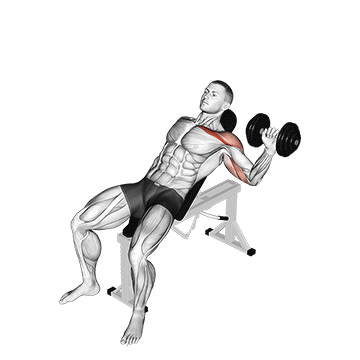
1. Start by selecting a dumbbell of appropriate weight. Remember, it's better to start light and increase weight as needed to maintain proper form.
2. Sit on an incline bench set to 45 degrees. Hold the dumbbell in your right hand.
3. Lay back on the bench, keeping the dumbbell close to your chest. Your feet should be flat on the floor.
4. Extend your right arm straight up, lifting the dumbbell towards the ceiling. Keep your left hand on your left hip or use it to stabilize yourself on the bench.
5. Lower the dumbbell slowly back down to your chest. This should be done in a controlled manner, ensuring your arm is moving in a vertical line.
6. Repeat this movement for your desired number of repetitions.
7. Once you've completed your set, switch the dumbbell to your left hand and repeat the process.
8. Remember to keep your movements slow and controlled, focusing on the contraction of your pec muscles.
9. Breathe in as you lower the dumbbell and breathe out as you press it upwards.
10. Ensure your back is flat against the bench throughout the exercise to avoid injury.
This exercise can be repeated for 2-3 sets of 8-12 reps on each side, depending on your strength and fitness level.
dumbbell one arm fly on exercise ball
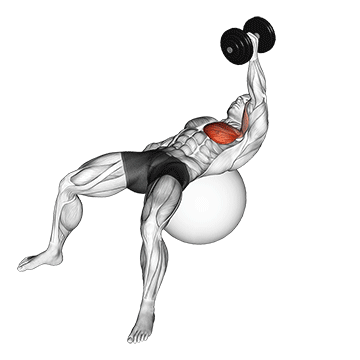
1. Start by selecting a dumbbell of appropriate weight. Remember, it's better to start light and increase weight as you get comfortable with the exercise.
2. Position yourself on an exercise ball, with your upper back and shoulders resting on the ball. Your feet should be flat on the floor, hip-width apart, and your knees bent at a 90-degree angle. This is your starting position.
3. Hold the dumbbell in your right hand, extending your arm straight up towards the ceiling. Your palm should be facing inwards, towards your feet.
4. Slowly lower the dumbbell in a wide arc, keeping your arm slightly bent. Lower it until it is level with your chest or until you feel a stretch in your chest muscles.
5. Pause for a moment, then use your chest muscles to reverse the movement and bring the dumbbell back to the starting position. Make sure to keep your arm slightly bent throughout the movement.
6. Repeat the exercise for the desired number of repetitions. Once you're done, switch the dumbbell to your left hand and repeat the exercise.
7. Remember to keep your hips lifted and your body in a straight line from your knees to your shoulders throughout the exercise. This will engage your core and provide stability.
8. Breathe in as you lower the dumbbell and breathe out as you lift it back up. This will help you maintain a steady rhythm and ensure your muscles are getting enough oxygen.
9. Always perform this exercise in a slow, controlled manner. Avoid using momentum to lift the dumbbell, as this can lead to injury.
dumbbell one arm decline chest press
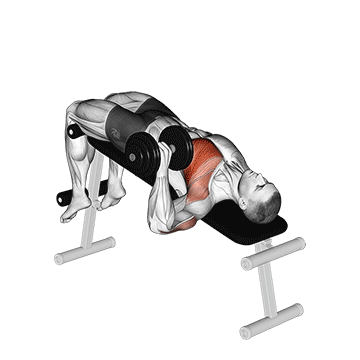
1. Start by selecting a dumbbell of appropriate weight. Remember, it's better to start light and increase weight as you get comfortable with the exercise.
2. Position yourself on a decline bench. Your feet should be secured at the end of the bench.
3. Hold the dumbbell in your right hand, palm facing your feet. Your arm should be extended straight above your chest. This is your starting position.
4. Slowly lower the dumbbell in an arc-like motion towards your chest. Keep your elbow slightly bent and ensure your arm is perpendicular to your body.
5. Pause for a moment when the dumbbell is just above your chest, then push the weight back up to the starting position. Make sure to exhale as you push the dumbbell up.
6. Repeat the movement for your desired number of repetitions.
7. Once you've completed your set, switch the dumbbell to your left hand and repeat the exercise.
8. Remember to keep your movements controlled, don't let the dumbbell drop quickly. The slower the movement, the more your pecs have to work.
9. Ensure your back is flat against the bench throughout the exercise to avoid injury.
10. Repeat for the desired number of sets.
This exercise primarily targets the lower part of the pectoral muscles, but also works the triceps and shoulders to a lesser extent.
dumbbell one arm chest fly on exercise ball
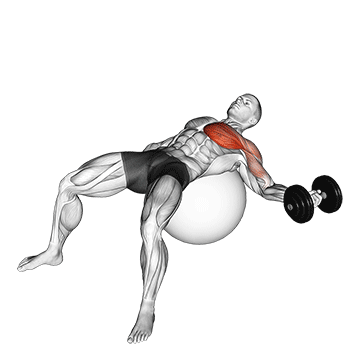
1. Start by selecting a dumbbell of appropriate weight. Remember, it's better to start light and increase weight as you get comfortable with the exercise.
2. Sit on an exercise ball with the dumbbell in your right hand. Walk your feet forward, rolling down the ball until your upper back and shoulders are resting on the ball. Your knees should be bent at a 90-degree angle, and your body should form a straight line from your knees to your head.
3. Extend your right arm straight up towards the ceiling, holding the dumbbell directly above your chest. Your palm should be facing inwards, towards your feet. This is your starting position.
4. Slowly lower the dumbbell in an arc motion out to your side, keeping your arm slightly bent. Continue lowering until your arm is parallel with the floor, or as far as comfortable. Ensure you maintain control of the dumbbell at all times.
5. Pause for a moment at the bottom of the movement, then slowly raise the dumbbell back to the starting position, following the same arc motion.
6. Repeat this movement for your desired number of repetitions. Once completed, switch the dumbbell to your left hand and repeat the exercise.
7. Remember to keep your hips lifted and your core engaged throughout the exercise to maintain stability on the ball.
8. This exercise should be performed in a slow and controlled manner to ensure you're targeting your pecs effectively. Avoid using momentum to lift the dumbbell, as this can lead to injury.
9. Always consult with a fitness professional if you're unsure about the correct form or weight for this exercise.
dumbbell one arm bench fly
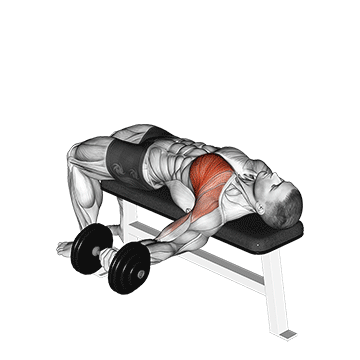
1. Start by selecting a dumbbell of appropriate weight. Remember, it's better to start light and increase weight as you get comfortable with the movement.
2. Sit on a flat bench with the dumbbell in one hand. Lay back onto the bench, keeping the dumbbell close to your chest.
3. Extend your arm holding the dumbbell straight up towards the ceiling. This is your starting position.
4. Slowly lower the dumbbell in a wide arc, keeping your arm slightly bent at the elbow. Continue lowering until your arm is parallel with the floor.
5. Pause for a moment at the bottom of the movement, then use your pecs to reverse the movement, bringing the dumbbell back up in the same wide arc.
6. Repeat this movement for your desired number of repetitions.
7. Once you've completed your set, switch the dumbbell to your other hand and repeat the exercise.
Remember to keep your movements slow and controlled, focusing on the stretch and contraction of the pecs. Avoid using your back or shoulders to lift the weight, and keep your feet flat on the floor throughout the exercise for stability.
dumbbell lying pullover on exercise ball
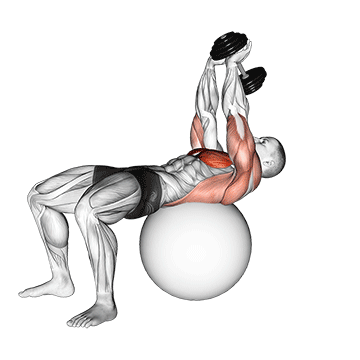
1. Start by selecting a dumbbell of appropriate weight. Remember, it's always better to start light and gradually increase the weight as you get comfortable with the exercise.
2. Position an exercise ball on the floor and sit down on it. Hold the dumbbell with both hands, extending your arms straight above your chest. The dumbbell should be held in a diamond shape by connecting both palms under the inner plate of the dumbbell.
3. Slowly walk your feet forward, rolling down the ball until only your upper back and shoulders are resting on it. Your body should be parallel to the floor, forming a straight line from your knees to your head.
4. Keep your hips elevated and your knees bent at a 90-degree angle. This is your starting position.
5. Inhale and slowly lower the dumbbell back over your head while keeping your arms extended. Continue the movement until the dumbbell is level with your head or you feel a stretch in your chest.
6. Exhale and pull the dumbbell back up to the starting position using your chest muscles. Ensure your arms remain straight throughout the movement.
7. Repeat this movement for the desired number of repetitions.
8. To safely dismount from the ball, drop your hips towards the floor and walk your feet back towards the ball until you are sitting upright again.
Remember to keep your movements slow and controlled, focusing on the stretch and contraction of the chest muscles. Avoid letting your lower back sag or your arms bend at the elbows to maintain proper form and prevent injury.
dumbbell lying one arm press v. 2
1. Start by lying flat on your back on a bench, feet firmly planted on the floor. Hold a dumbbell in one hand, with your arm fully extended towards the ceiling. This is your starting position.
2. Slowly lower the dumbbell down and across your body, bending your elbow and keeping your arm close to your side. The dumbbell should end up near your opposite shoulder.
3. Pause for a moment, then press the dumbbell back up to the starting position, extending your arm fully but without locking your elbow.
4. Repeat this movement for your desired number of repetitions, then switch to the other arm.
5. Remember to keep your movements slow and controlled, focusing on the contraction of your pec muscles. Don't let the dumbbell drop quickly - the lowering phase is just as important as the lifting phase.
6. Keep your back flat against the bench throughout the exercise, and avoid lifting your hips off the bench as you press the dumbbell up.
7. This exercise can be performed for multiple sets, typically between 3-5 sets of 8-12 reps each, depending on your strength and fitness level.
Remember to choose a weight that is challenging but allows you to maintain proper form throughout the exercise.
dumbbell lying one arm press
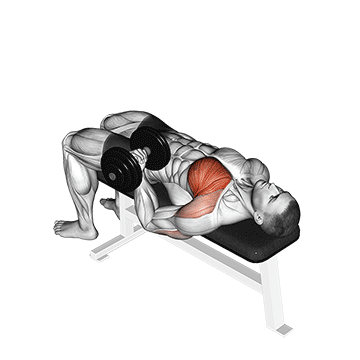
1. Start by selecting a dumbbell of appropriate weight. Remember, it's better to start light and increase weight as you get comfortable with the exercise.
2. Lie flat on your back on a bench. Hold the dumbbell in your right hand, with your arm fully extended above your chest. Your palm should be facing towards your feet. This is your starting position.
3. Slowly lower the dumbbell down and across your body towards your left shoulder. Keep your arm slightly bent at the elbow to prevent strain.
4. Pause for a moment when the dumbbell is just above your chest, then push the weight back up to the starting position. Make sure to use your chest muscles to push the weight up, not just your arm.
5. Repeat this movement for your desired number of repetitions.
6. Once you've completed your set, switch the dumbbell to your left hand and repeat the exercise for the same number of repetitions.
7. Remember to keep your movements slow and controlled, focusing on the muscle contraction and not on the weights you are lifting.
8. Breathe in as you lower the dumbbell, and breathe out as you press it back up.
9. Always keep your back flat on the bench and avoid lifting your body off the bench as you press the dumbbell.
10. Repeat for the desired number of sets.
This exercise targets the pectoral muscles, but also works the triceps and shoulders to a lesser extent.
dumbbell lying hammer press
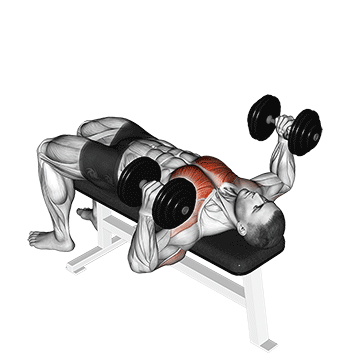
1. Start by selecting a pair of dumbbells of appropriate weight. Remember, it's always better to start light and gradually increase the weight as you get comfortable with the exercise.
2. Lie down on a flat bench with your feet firmly planted on the ground. Hold the dumbbells in each hand with your palms facing each other. This is the starting position.
3. Extend your arms fully above your chest, but don't lock your elbows. The dumbbells should be just about touching each other.
4. Slowly lower the dumbbells to the sides of your chest by bending your elbows and keeping your wrists straight. Ensure your elbows are slightly below your shoulders. The dumbbells should be parallel to each other.
5. Pause for a moment when the dumbbells are at chest level, then push them back up to the starting position. Make sure to exhale as you push the dumbbells up.
6. Repeat this movement for the desired number of repetitions.
Remember to keep your movements slow and controlled, focusing on the contraction and stretch of the pec muscles. Avoid letting the dumbbells touch the chest at the bottom of the movement, and don't let them bang together at the top. This will ensure maximum muscle engagement and prevent any potential injuries.
dumbbell incline twisted flyes
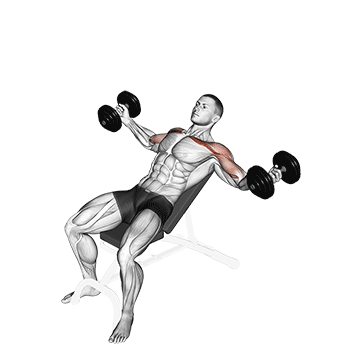
1. Start by selecting a pair of dumbbells of appropriate weight. Remember, it's better to start light and increase weight as you get comfortable with the movement.
2. Sit down on an incline bench set at about a 45-degree angle. Hold a dumbbell in each hand and lie back on the bench.
3. Extend your arms out to your sides, keeping a slight bend in your elbows. Your palms should be facing each other. This is your starting position.
4. Slowly lower the dumbbells in a wide arc until they are level with your chest. Keep your elbows slightly bent throughout the movement.
5. As you bring the dumbbells back up to the starting position, twist your wrists so that your palms are facing each other. This is the "twist" in the exercise.
6. Squeeze your pecs at the top of the movement for a second before lowering the dumbbells again.
7. Repeat this movement for your desired number of repetitions.
Remember to keep your movements slow and controlled, focusing on the muscle contraction and not on the weights you are lifting. Avoid using your back or shoulders to lift the weights; your pecs should be doing the work.
dumbbell incline press on exercise ball
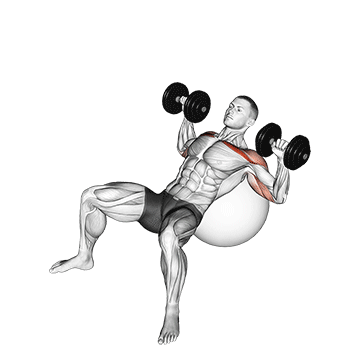
1. Start by selecting a pair of dumbbells of appropriate weight. Remember, it's always better to start light and gradually increase the weight as you get comfortable with the exercise.
2. Sit on an exercise ball with the dumbbells resting on your thighs. The palms of your hands should be facing each other.
3. Slowly walk your feet forward, rolling down the ball until your upper back and shoulders are resting on the ball. Your knees should be bent at a 90-degree angle, and your body should form a straight line from your knees to your shoulders.
4. Push the dumbbells up so that they are directly above your chest with your palms still facing each other. This is your starting position.
5. Lower the dumbbells to the sides of your chest by bending your elbows and allowing your shoulder blades to come together. Keep your elbows at a 90-degree angle.
6. Push the dumbbells back up to the starting position by extending your arms and contracting your chest muscles.
7. Repeat this movement for the desired number of repetitions.
8. After completing your set, carefully walk your feet back towards the ball, allowing your body to sit up.
Remember to keep your movements slow and controlled throughout the exercise, focusing on the muscle contraction and not on the weights you are lifting. Always keep your core engaged to maintain balance on the ball.
dumbbell incline palm-in press
To perform the dumbbell incline palm-in press, start by setting an incline bench at a 45-degree angle.
1. Sit on the bench with a dumbbell in each hand. Your feet should be flat on the ground for stability.
2. Lie back on the bench, bringing the dumbbells up to shoulder level. Your palms should be facing each other, hence the 'palm-in' in the name of the exercise.
3. Push the dumbbells up and together, extending your arms fully but without locking your elbows. This is your starting position.
4. Slowly lower the dumbbells back down to the sides of your chest. Ensure that you maintain the 'palm-in' position throughout the movement.
5. Once the dumbbells are at chest level, push them back up to the starting position.
6. Repeat this movement for your desired number of repetitions.
Remember to keep your movements controlled, focusing on the contraction of your pecs as you push the dumbbells up and the stretch as you lower them down. This exercise not only targets your pecs but also works your shoulders and triceps.
dumbbell incline one arm press on exercise ball
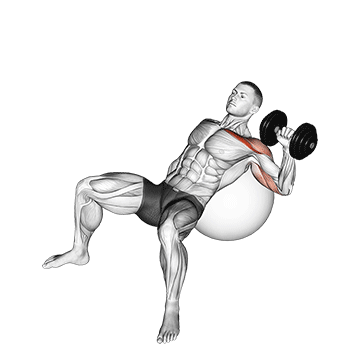
1. Start by selecting a dumbbell of appropriate weight. Remember, it's better to start light and increase weight as you get comfortable with the exercise.
2. Position an exercise ball near the incline bench. Sit on the ball and roll forward until your upper back and shoulders are resting on the ball. Your feet should be flat on the floor, knees bent at a 90-degree angle.
3. Hold the dumbbell in your right hand, palm facing forward. Your arm should be extended straight up towards the ceiling. This is your starting position.
4. Slowly lower the dumbbell down and to the side until your elbow is at about a 90-degree angle. Keep your elbow close to your body throughout the movement.
5. Push the dumbbell back up to the starting position, focusing on using your pecs to drive the movement.
6. Repeat for the desired number of reps, then switch to your left hand and repeat the exercise.
7. Remember to keep your hips lifted and your body in a straight line from your knees to your shoulders throughout the exercise. This will engage your core and provide stability.
8. Breathe in as you lower the dumbbell and breathe out as you press it back up.
9. Always maintain control of the dumbbell, don't let it drop or use momentum to lift it. The movement should be slow and controlled for maximum muscle engagement.
10. Repeat this exercise for 2-3 sets of 8-12 reps on each side.
dumbbell incline one arm press
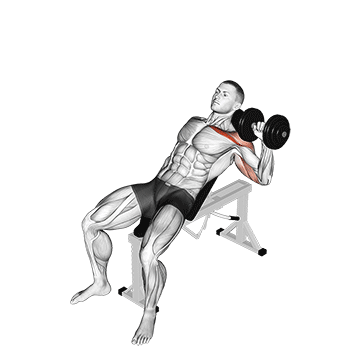
1. Start by selecting a dumbbell of appropriate weight. Remember, it's better to start light and increase weight as you get comfortable with the exercise.
2. Sit down on an incline bench set at about a 45-degree angle. Hold the dumbbell in one hand at shoulder level, with your palm facing forward.
3. Plant your feet firmly on the ground and engage your core. This will help maintain balance throughout the exercise.
4. Press the dumbbell upward until your arm is fully extended, but not locked. Ensure the movement is controlled and steady.
5. Pause for a moment at the top, then slowly lower the dumbbell back to the starting position. This counts as one rep.
6. Repeat the exercise for your desired number of repetitions. Once completed, switch to the other arm and repeat the same number of reps.
7. Remember to keep your back flat against the bench throughout the exercise. This will help isolate the pecs and reduce the risk of injury.
8. Breathe in as you lower the dumbbell and breathe out as you press it upward. This will help maintain a steady rhythm and ensure your muscles are getting enough oxygen.
9. Always maintain control of the dumbbell. Do not let it drop quickly or bounce at the bottom of the movement.
10. As you get comfortable with the exercise, gradually increase the weight of the dumbbell to continue challenging your muscles.
dumbbell incline one arm fly on exercise ball
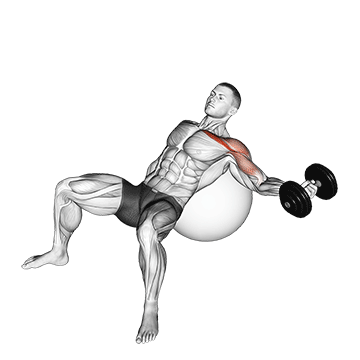
1. Start by selecting a dumbbell of appropriate weight. Remember, it's better to start light and increase weight as you get comfortable with the exercise.
2. Position an exercise ball near the incline bench. Sit on the ball and carefully walk your feet forward, allowing the ball to roll underneath your body until it supports your upper back and shoulders. Your knees should be bent at a 90-degree angle with your feet flat on the floor.
3. Hold the dumbbell in your right hand with your arm fully extended above your chest, palm facing inwards. Your left hand can rest on your hip or hold onto the bench for stability.
4. Slowly lower the dumbbell in a wide arc, keeping your arm slightly bent, until it is level with your chest. You should feel a stretch in your pecs.
5. Pause for a moment, then use your pecs to reverse the movement and bring the dumbbell back to the starting position. Make sure to keep your arm slightly bent throughout the movement to avoid straining your elbow.
6. Repeat the exercise for your desired number of reps, then switch to your left hand and repeat the process.
7. Remember to keep your movements slow and controlled, focusing on the muscle contraction and not on the weights you are lifting.
8. Always maintain a neutral spine and avoid arching your back. If you find your back arching, reduce the weight of the dumbbell.
9. This exercise can be performed in sets of 8-12 reps, with 1-2 minutes rest between sets.
10. As with any exercise, it's important to warm up before starting and cool down afterwards.
dumbbell incline one arm fly
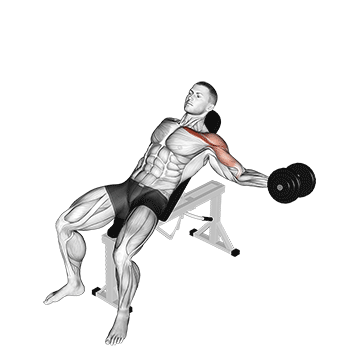
To perform the dumbbell incline one arm fly, start by setting an incline bench at a 45-degree angle.
1. Sit on the bench with a dumbbell in one hand. Your feet should be flat on the floor for stability.
2. Lean back onto the bench, bringing the dumbbell up to shoulder height. Your arm should be extended out to the side, but slightly bent at the elbow. This is your starting position.
3. Slowly lower the dumbbell in an arc-like motion down and away from your body. Keep your arm slightly bent throughout the movement.
4. Continue lowering the weight until you feel a stretch in your chest.
5. Pause for a moment, then reverse the movement, bringing the dumbbell back up to the starting position in the same arc-like motion.
6. Squeeze your chest muscles at the top of the movement.
7. Repeat for the desired number of reps, then switch to the other arm.
Remember to keep your movements slow and controlled, and avoid using your back or shoulders to lift the weight. The focus should be on your pecs.
dumbbell incline hammer press
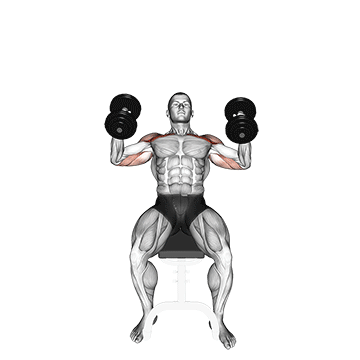
To perform the dumbbell incline hammer press, start by setting your incline bench at a 45-degree angle.
1. Sit down on the bench with a dumbbell in each hand resting on your thighs. The palms of your hands will be facing each other.
2. Then, using your thighs to help raise the dumbbells, lift the dumbbells one at a time so you can hold them out to your sides at shoulder level.
3. Once you have the dumbbells raised to shoulder level, rotate your wrists forward so that the palms of your hands are facing away from you. This will be your starting position.
4. Now, breathe out and push the dumbbells up with your chest. The dumbbells should be just to the sides of your chest, with your upper arm and forearm creating a 90-degree angle at elbow joint.
5. Keep full control of the dumbbells at all times. Hold for a second at the contracted position, squeeze your chest, then begin to lower the weights slowly to the starting position while breathing in.
6. Repeat the movement for the prescribed amount of repetitions.
Remember to keep your back and shoulders pressed against the bench throughout the exercise. The key to this exercise is keeping the dumbbells in a neutral grip, with your palms facing each other. This is what makes it a 'hammer' press.
dumbbell incline fly on exercise ball
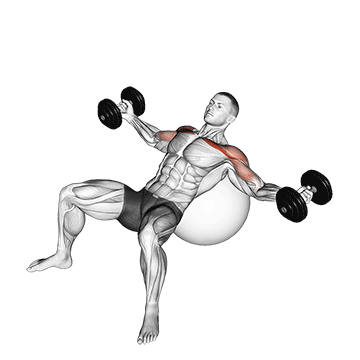
1. Start by selecting a pair of dumbbells of appropriate weight. Remember, it's better to start light and increase weight as you get comfortable with the exercise.
2. Position an exercise ball near the incline bench. Sit on the ball and walk your feet forward, rolling the ball up your back until it supports your upper back and shoulders. Your knees should be bent at a 90-degree angle with your feet flat on the floor.
3. Hold a dumbbell in each hand with your arms extended above your chest, palms facing each other. This is your starting position.
4. Slowly lower the dumbbells out to your sides in a wide arc while keeping your elbows slightly bent. Continue lowering the weights until you feel a stretch in your chest muscles.
5. Pause for a moment at the bottom of the movement, then slowly reverse the motion, bringing the dumbbells back to the starting position as if you're hugging a large tree.
6. Squeeze your chest muscles at the top of the movement for a second, then repeat the exercise for the desired number of repetitions.
7. Remember to keep your movements slow and controlled, and avoid letting the dumbbells touch at the top of the movement to maintain tension in your chest muscles.
8. Always keep your back pressed against the ball and your core engaged throughout the exercise to protect your spine and maximize the effectiveness of the exercise.
9. After completing your set, carefully set the dumbbells down before getting up from the exercise ball.
Remember, the key to this exercise is control, not speed or the amount of weight. It's more important to perform the exercise correctly than to lift heavier weights.
dumbbell incline fly
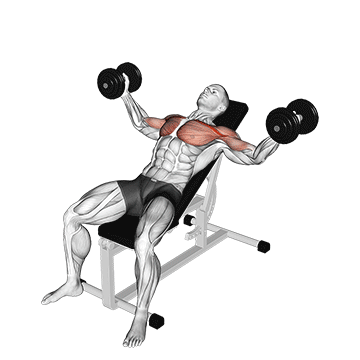
1. Start by selecting a pair of dumbbells that you can comfortably lift.
2. Sit on an incline bench set at an angle of 45 degrees.
3. Hold a dumbbell in each hand and lie back on the bench.
4. Extend your arms above your chest with a slight bend at the elbows. The dumbbells should be just about touching each other. This is your starting position.
5. Slowly lower the weights in an arc-like motion on either side of your body until you feel a stretch in your chest. Keep your elbows slightly bent throughout the movement to prevent strain.
6. Pause for a moment at the bottom of the movement, then slowly bring the weights back up in the same arc-like motion, squeezing your chest muscles as you do so.
7. Repeat this movement for the desired number of repetitions.
8. Ensure to keep your movements slow and controlled, focusing on the muscle contraction and not on the weights you are lifting.
9. Remember to breathe in as you lower the weights and breathe out as you lift them back up.
10. Always maintain a slight bend in your elbows to avoid straining your joints.
11. Keep your back flat on the bench throughout the exercise to maintain proper form and prevent injury.
12. If you feel any discomfort or pain during the exercise, stop immediately and consult with a fitness professional.
dumbbell incline breeding
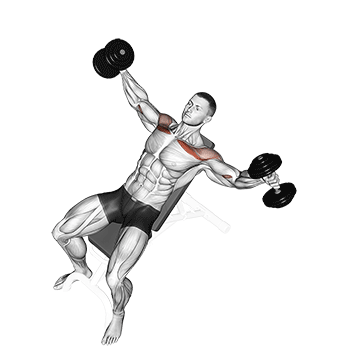
1. Start by setting up an incline bench at a 45-degree angle.
2. Grab a pair of dumbbells that you're comfortable with. Make sure they're not too heavy to avoid injury.
3. Sit down on the incline bench with a dumbbell in each hand. Rest the dumbbells on your thighs near your knees.
4. Lean back onto the bench, bringing the dumbbells up to shoulder level. Your palms should be facing forward.
5. Press the dumbbells up over your chest, extending your arms fully. This is your starting position.
6. Slowly lower the dumbbells in a wide arc until they are level with your chest. Keep your elbows slightly bent to avoid strain.
7. Pause for a moment at the bottom of the movement, then press the dumbbells back up to the starting position. This is one repetition.
8. Repeat this movement for your desired number of repetitions.
9. Ensure to keep your movements slow and controlled, focusing on the contraction of your pec muscles.
10. After completing your set, carefully lower the dumbbells back to your thighs before standing up.
Remember to always maintain proper form and never use a weight that's too heavy for you to handle safely.
dumbbell incline bench press
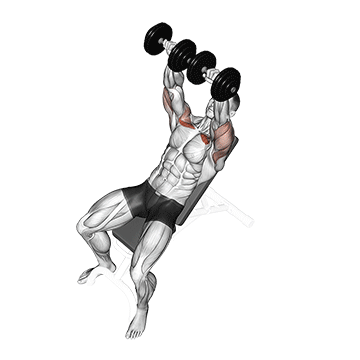
1. Start by setting up your incline bench at a 45-degree angle.
2. Sit down on the bench with a dumbbell in each hand resting on your thighs. The palms of your hands should be facing each other.
3. Lean back and bring the dumbbells up to shoulder width, the palms of your hands should be facing towards your feet. This is your starting position.
4. Push the dumbbells up with your chest. The dumbbells should be just to the sides of your chest, with your upper arm and forearm creating a 90-degree angle at elbow joint.
5. Breathe out as you push the dumbbells up with your chest. Lock your arms at the top, hold for a second, and then start slowly lowering the weight.
6. Lower the weights back down to the starting position while inhaling.
7. Repeat the movement for the prescribed amount of repetitions.
8. When you are done, do not drop the dumbbells next to you as this is dangerous to your rotator cuff in your shoulders and others working out around you.
9. Just lower the dumbbells back down to your thighs and then stand up.
Remember to keep your back and hips firmly pressed against the bench throughout the exercise. The movement should be controlled, not allowing the dumbbells to fall under gravity.
dumbbell incline alternate press
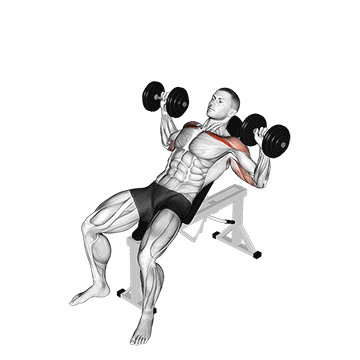
To perform the dumbbell incline alternate press, start by setting an incline bench at a 45-degree angle.
1. Sit on the bench with a dumbbell in each hand. Your feet should be flat on the ground for stability.
2. Start with your arms fully extended above your chest, palms facing away from you. This is your starting position.
3. Slowly lower one dumbbell to the side of your chest while keeping the other dumbbell in the starting position. Keep your elbows at a 90-degree angle as you lower the weight.
4. Push the dumbbell back up to the starting position, fully extending your arm but not locking your elbow.
5. Repeat the movement with the other arm. This is one rep.
6. Perform your desired number of reps and sets.
Remember to keep your movements controlled, focusing on the muscle contraction and not on the weights you are lifting. Breathe in as you lower the weight and breathe out as you press it back up.
dumbbell fly on exercise ball
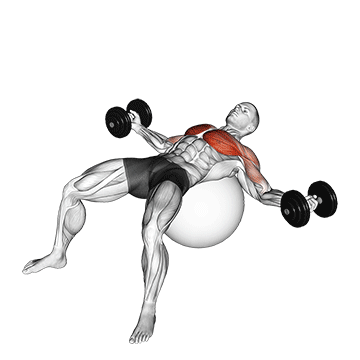
1. Start by selecting a pair of dumbbells that you can comfortably lift.
2. Sit on an exercise ball with the dumbbells in your hands. Slowly walk your feet forward, rolling the ball up your back until it is supporting your upper back and shoulders. Your knees should be bent at a 90-degree angle, and your body should form a straight line from your knees to your shoulders.
3. Hold the dumbbells directly above your chest with your palms facing each other. Your elbows should be slightly bent.
4. Slowly lower the dumbbells out to your sides in a wide arc, keeping your elbows slightly bent. Continue lowering the weights until your chest muscles are stretched and your elbows are at about the same level as your chest.
5. Pause for a moment at the bottom of the movement, then slowly raise the dumbbells back to the starting position, following the same wide arc.
6. Squeeze your chest muscles at the top of the movement. This completes one repetition.
7. Perform your desired number of repetitions, then carefully walk your feet back towards the ball, rolling it down your back until you are sitting upright again.
Remember to keep your movements slow and controlled, and to keep your abs engaged to help maintain your balance on the ball.
dumbbell fly
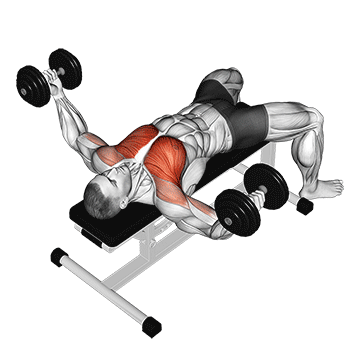
1. Start by selecting a pair of dumbbells that you can comfortably lift. Remember, the goal is not to strain yourself but to work your muscles effectively.
2. Sit down on a flat bench with a dumbbell in each hand resting on your thighs. The palms of your hands should be facing each other.
3. Slowly lie back on the bench, keeping the dumbbells close to your chest. Extend your arms out to your sides in a wide arc, keeping a slight bend at your elbows to prevent strain. This is your starting position.
4. With a smooth, controlled motion, lift the dumbbells in a wide arc up and over your chest until they meet above the centerline of your body. As you lift, visualize hugging a large tree trunk; this is the motion you're aiming for.
5. At the top of the movement, squeeze your pecs together for a second to maximize the contraction.
6. Slowly lower the dumbbells back along the same wide arc until they are level with your chest. Make sure to keep the same slight bend in your elbows throughout the movement.
7. Repeat this movement for your desired number of repetitions.
Remember to keep your movements slow and controlled, focusing on the muscle contraction and not on the weights you are lifting. Avoid using your back or shoulders to lift the weights; your pecs should be doing the work. Breathe in as you lower the weights and breathe out as you lift them.
dumbbell decline twist fly
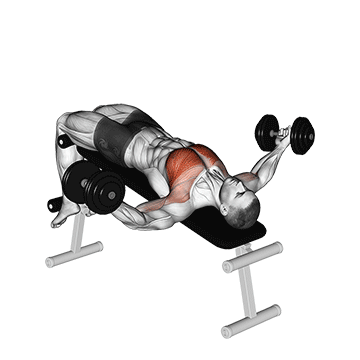
1. Start by setting up your decline bench at an angle of about 30 to 45 degrees.
2. Grab a pair of dumbbells of appropriate weight and sit on the decline bench with the dumbbells resting on your thighs.
3. Lay back onto the bench, bringing the dumbbells with you. Hold the dumbbells above your chest with your arms fully extended and your palms facing each other.
4. Slightly bend your elbows and maintain this bend throughout the exercise. This is your starting position.
5. Slowly lower the dumbbells in a wide arc motion out to your sides, keeping your arms perpendicular to the angle of the bench. Continue lowering until you feel a stretch in your chest.
6. From this position, start to bring the dumbbells back up in the same wide arc motion. As you do this, twist your wrists so that your palms face towards your feet.
7. Continue to lift the dumbbells until they are directly above your chest again. Squeeze your chest muscles at the top of the movement.
8. Reverse the motion, untwisting your wrists so that your palms face each other again as you lower the dumbbells back down to the starting position.
9. Repeat for the desired number of repetitions.
Remember to keep your movements slow and controlled, focusing on the muscle contraction and not on the weights you are lifting. Always keep your back flat on the bench and do not use your arms to lift the weight; your chest should be doing the work.
dumbbell decline one arm fly
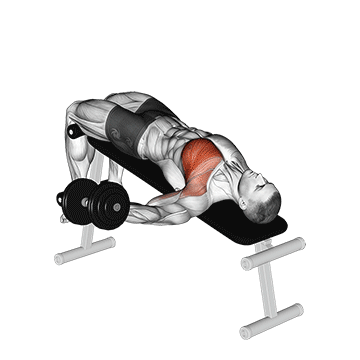
1. Start by setting up your decline bench at an angle of about 30 to 45 degrees.
2. Grab a dumbbell in one hand and sit on the decline bench. Secure your legs at the end of the bench.
3. Lay back and hold the dumbbell directly above your chest with your arm fully extended. Your palm should be facing inwards towards your body. This is your starting position.
4. Slowly lower the dumbbell in a wide arc, keeping your arm slightly bent, until you feel a stretch in your chest.
5. From this position, use your chest to bring the dumbbell back to the starting position as you breathe out. Keep the same slight bend in your elbow throughout the movement.
6. Repeat for the recommended amount of repetitions and then switch arms.
7. It's important to do this exercise slowly and deliberately to avoid injury. Also, do not use a weight that is too heavy that it causes you to use your back or shoulders extensively. The focus should be on the pecs.
8. Always ensure your movement is controlled, inhaling as you lower the weight and exhaling as you lift.
9. Repeat the exercise for the desired number of sets.
Remember, the key to this exercise is to isolate the pecs and minimize the involvement of the shoulders and back.
dumbbell decline hammer press
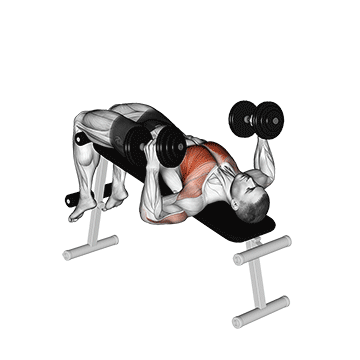
To perform the dumbbell decline hammer press, follow these steps:
1. Start by setting up your decline bench at an angle of about 30 to 45 degrees.
2. Sit on the bench with a dumbbell in each hand. Your feet should be secured under the foot pads.
3. Lay back on the bench, bringing the dumbbells to the sides of your chest. Your palms should be facing each other in a neutral grip, this is also known as a hammer grip.
4. Push the dumbbells up and away from your chest until your arms are fully extended. This is your starting position.
5. Slowly lower the dumbbells back down to the sides of your chest. Make sure to keep your elbows close to your body to engage your pecs.
6. Push the dumbbells back up to the starting position, squeezing your chest muscles at the top of the movement.
7. Repeat this movement for your desired number of repetitions.
Remember to keep your movements controlled, don't let the dumbbells drop quickly. The slower the movement, the more your muscles have to work. Also, ensure to keep your back flat against the bench throughout the exercise to avoid injury.
dumbbell decline fly
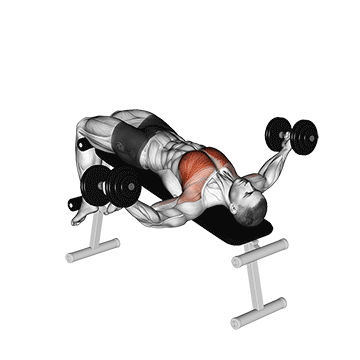
To perform the dumbbell decline fly, start by securing your legs at the end of the decline bench and then lie down. With a dumbbell in each hand, extend your arms above you, keeping a slight bend at your elbows to prevent strain. Your palms should be facing each other.
Slowly lower the weights in a wide arc until you feel a stretch in your chest. The dumbbells should be lowered to either side of your body, not straight down. Keep your arms steady and move only your shoulders.
Pause for a moment at the bottom of the movement, then bring the weights back up in the same wide arc. Imagine that you're hugging a large tree while performing the exercise. Squeeze your chest muscles at the top of the lift.
Remember to keep your movements slow and controlled€”don't let the weights drop or use your body's momentum to lift them. Repeat the exercise for your desired number of repetitions.
dumbbell decline bench press
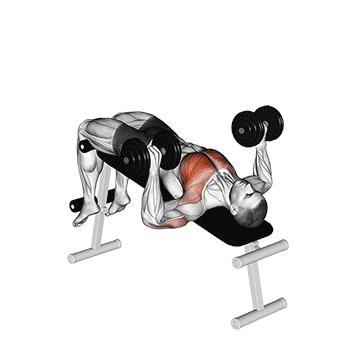
1. Start by setting up your decline bench at an angle of about 30 to 45 degrees.
2. Once the bench is set, sit down on it with a dumbbell in each hand. Your feet should be securely fastened under the foot pads.
3. Lay back onto the bench, bringing the dumbbells up to shoulder level. Your palms should be facing towards your feet and the dumbbells should be just outside your shoulders.
4. Take a deep breath and press the dumbbells up over your chest by extending your arms. The dumbbells should be directly above your chest and your arms should be perpendicular to the floor.
5. Slowly lower the dumbbells back down to the starting position as you exhale. The dumbbells should be lowered to the sides of your chest.
6. Repeat this movement for your desired number of repetitions.
7. When you're done, carefully place the dumbbells on the floor or on a nearby rack.
Remember to keep your movements controlled and steady, and to not let the dumbbells fall too far down as this can strain your shoulders. Always use a weight that is challenging but manageable for you.
dumbbell bench press
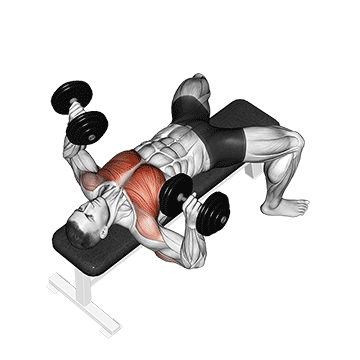
1. Start by sitting on a flat bench with a dumbbell in each hand. Your feet should be flat on the floor for stability.
2. Slowly lie back on the bench, bringing the dumbbells to the sides of your chest. Your palms should be facing towards your feet and the dumbbells should be just to the sides of your chest, with your upper arm and forearm creating a 90-degree angle at elbow joint.
3. Push the dumbbells up and away from your chest, extending your arms fully. Ensure your shoulder blades remain firmly on the bench. This is your starting position.
4. Slowly lower the dumbbells back down to the sides of your chest. Make sure to keep your elbows at a 90-degree angle and do not let them flare out to the sides.
5. Push the dumbbells back up to the starting position, squeezing your chest muscles as you do so.
6. Repeat this movement for your desired number of repetitions.
Remember to keep your movements slow and controlled, focusing on the muscle contraction and not on the weights you are lifting. Always keep your back flat on the bench to avoid injury.
dumbbell around pullover
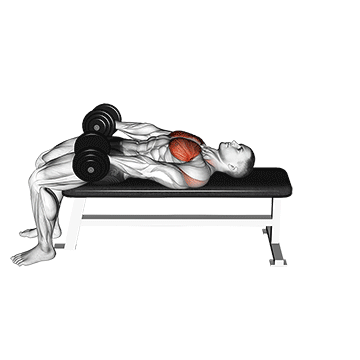
To perform the dumbbell around pullover, follow these steps:
1. Start by lying down on a flat bench. Your feet should be flat on the ground for stability.
2. Hold a dumbbell with both hands, extending your arms straight above your chest. The dumbbell should be held in a vertical position, with your palms pressing against the underside of one of the weight plates. This will be your starting position.
3. Keeping your arms straight, lower the weight in an arc behind your head while breathing in. You should feel a stretch in your chest and biceps.
4. Bring the dumbbell back to the starting position using the same arc motion while exhaling. Ensure your arms remain straight throughout the movement.
5. Repeat this motion for the desired number of repetitions.
Remember to keep your movements slow and controlled, and avoid letting the dumbbell drop too far behind you to prevent injury. This exercise primarily targets the pecs, but also works the lats and triceps.
deep push up
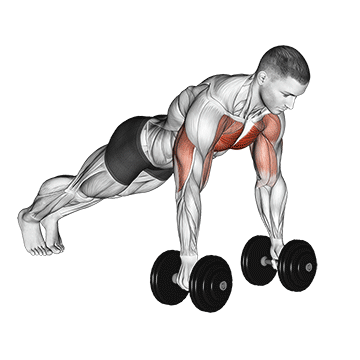
1. Start by selecting a pair of dumbbells that you're comfortable with. Ensure they are not too heavy to compromise your form or too light to not provide enough resistance.
2. Place the dumbbells on the floor, parallel to each other and slightly wider than shoulder-width apart.
3. Position yourself into a high plank position, with your hands gripping the dumbbells. Your body should form a straight line from your head to your heels.
4. Lower your body towards the floor by bending your elbows, keeping them close to your body. Ensure your back remains straight and your hips don't sag.
5. Push your body back up to the starting position by extending your arms fully. This completes one rep.
6. Aim to do 3 sets of 10-15 reps each, depending on your fitness level.
Remember to keep your core engaged throughout the exercise and maintain a steady, controlled movement. This exercise not only targets your pecs but also works your arms and core.
No tags for this post.
